Experimental Study of Aerodynamic and Bird Exclusion Characteristics of a Branched Turboprop Inlet Under Ground Suction Conditions
Abstract
1. Introduction
2. Experimental Setup
2.1. Test Model
2.2. Experimental System
2.3. Bird Dummy Selection and Preparation
3. Terminological Definitions
4. Results and Discussion
4.1. Aerodynamic Characteristics of the Inlet
4.2. Exclusion Characteristics of the Inlet
4.3. Aerodynamic Effects of the Bird on the Inlet
5. Conclusions
Author Contributions
Funding
Data Availability Statement
Conflicts of Interest
Nomenclature
| Inlet throat area | |
| Core duct exit area | |
| Bypass duct exit area | |
| DC60 | Total pressure distortion index |
| k | Ratio of specific heat of air |
| Bird dummy length | |
| Distance of entrance from the AIP | |
| Bird dummy weight | |
| Mach number at the AIP | |
| Mach number at the outlet of the bypass duct | |
| Average static pressure at the AIP | |
| Average total pressure at the AIP | |
| Average static pressure at the outlet of the bypass duct | |
| Average total pressure at the outlet of the bypass duct | |
| Freestream static pressure | |
| Freestream total pressure | |
| Minimum total pressure in any sector region with the azimuthal angle of 60° | |
| Average dynamic pressure at the AIP | |
| Core duct outside radius | |
| Bypass duct radius | |
| Core duct inside radius | |
| Incident velocity of the bird | |
| Incident angle of the bird | |
| Total pressure recovery coefficient | |
| AIP | Aerodynamic interface plane |
| CFD | Computational fluid dynamics |
| ESP | Electronically scanned pressure |
| FOE | Foreign object exclusion |
| PSI | PRESSURE SYSTEMS INTERNATIONAL INC. |
| 6–DOF | Six–degree–of–freedom |
References
- Balli, O.; Hepbasli, A. Energetic and exergetic analyses of t56 turboprop engine. Energy Convers. Manag. 2013, 73, 106–120. [Google Scholar] [CrossRef]
- Aygun, H. Effects of air to fuel ratio on parameters of combustor used for gas turbine engines: Applications of turbojet, turbofan, turboprop and turboshaft. Energy 2024, 305, 132346. [Google Scholar] [CrossRef]
- Voskuijl, M.; Van Bogaert, J.; Rao, A.G. Analysis and design of hybrid electric regional turboprop aircraft. CEAS Aeronaut. J. 2018, 9, 15–25. [Google Scholar] [CrossRef]
- Saravanamuttoo, H. Modern turboprop engines. Prog. Aerosp. Sci. 1987, 24, 225–248. [Google Scholar] [CrossRef]
- Balli, O. Advanced exergy analyses of an aircraft turboprop engine (tpe). Energy 2017, 124, 599–612. [Google Scholar] [CrossRef]
- Zheng, G.; Tan, H.; Wu, Z.; Zhang, F.; Zhang, Y.; Luo, G. Aerodynamics and bird ingestion characteristics of a bulge-adjustable turboprop engine inlet. Aerosp. Sci. Technol. 2024, 144, 108777. [Google Scholar] [CrossRef]
- Meguid, S.A.; Mao, R.H.; Ng, T.Y. FE analysis of geometry effects of an artificial bird striking an aeroengine fan blade. Int. J. Impact Eng. 2008, 35, 487–498. [Google Scholar] [CrossRef]
- Zhou, G.; Zhou, H.; Wu, Z.; Tan, H.; Qin, W. Ice object exclusion characteristics of turboshaft engine inlet under helicopter/inlet integration conditions. Aerospace 2024, 12, 458. [Google Scholar] [CrossRef]
- Mi, B. A CFD–CSD coupling method for simulating the dynamic impact and expulsion of fragile foreign objects from the ‘inlet–bypass duct’junction of a turboprop aircraft. Eng. Appl. Comput. Fluid Mech. 2022, 16, 73–94. [Google Scholar]
- Wu, Z.; Shi, Z.; Sun, S.; Tan, H. Two-phase flow characteristics inside a serpentine inlet in heavy rain. Phys. Fluids 2025, 37. [Google Scholar] [CrossRef]
- Li, C.; Bin, G.; Li, J.; Yang, P.; Wang, W. Influence of inlet distortion on the wear of aero-compressor blades. Int. J. Mech. Sci. 2022, 120, 107551. [Google Scholar] [CrossRef]
- Mohamed, B.; Ahmed, F.; Galal, B. Effect of erodent particle initial velocity on the erosion of propeller blades for turboprop engines. In Proceedings of the 27th Joint Propulsion Conference, Sacramento, CA, USA, 24–26 June 1991. [Google Scholar]
- Mohamed, B.; Ahmed, F.; Galal, B. Numerical simulation of the aerodynamic behavior of propeller blades at subsonic conditions. In Proceedings of the 27th Joint Propulsion Conference, Sacramento, CA, USA, 24–26 June 1991. [Google Scholar]
- Zhou, H.; Wu, Z.; Tan, H.; Zheng, G.; Zhang, F.; Luo, G.; Chen, W. Numerical simulation on bird ingestion characteristics from engine inlet of turboprop aircraft. J. Aerosp. Power 2024, 39, 202300831. [Google Scholar]
- Zhang, D.; Fei, Q. Effect of bird geometry and impact orientation in bird striking on a rotary jet-engine fan analysis using SPH method. Aerosp. Sci. Technol. 2016, 54, 320–329. [Google Scholar] [CrossRef]
- Mao, R.H.; Meguid, S.A.; Ng, T.Y. Finite element modeling of a bird striking an engine fan blade. J. Aircr. 2007, 44, 583–596. [Google Scholar] [CrossRef]
- Zheng, G.; Wu, Z.; Tan, H.; Zhang, Y.; Wang, K. Design and examination of a turboprop inlet with scavenge duct. Chin. J. Aeronaut. 2023, 36, 32–42. [Google Scholar] [CrossRef]
- Barta, A.; Bennett, W.; Vittal, B.; Krishnan, M. Design and development of a compact bifurcated turboprop inlet. In Proceedings of the 27th Joint Propulsion Conference, Sacramento, CA, USA, 24–26 June 1991. [Google Scholar]
- Ruiz-Calavera, L.; Funes-Sebastian, D.; Perdones-Diaz, D. Powered model wind tunnel tests of a high-offset subsonic turboprop air intake. In Proceedings of the 46th AIAA/ASME/SAE/ASEE Joint Propulsion Conference & Exhibite, Nashville, TN, USA, 25–28 July 2010. [Google Scholar]
- Gula, P.; Ulma, D.; Zurek, K.; Zurawski, R. Challenges of turboprop engine installation on small aircraft. Aircr. Eng. Aerosp. Technol. 2019, 91, 938–948. [Google Scholar] [CrossRef]
- Zheng, G.; Wu, Z.; Tan, H.; Ren, J.; Zhang, Y.; Zhou, G. Aerodynamic study of a bifurcated turboprop engine inlet with a propeller for flow at ground suction conditions. Aerosp. Sci. Technol. 2024, 155, 109720. [Google Scholar] [CrossRef]
- Luo, G.; Xu, Z.; Shen, H.; Chen, W.; Zhang, H. Experimental study on the impact load of internally supported gelatin bird projectiles. Eng. Fail. Anal. 2021, 124, 105336. [Google Scholar] [CrossRef]
- Luo, G.; Mo, Y.; Wu, C.; Zhang, F.; Liu, L.; Chen, W. Experimental study of ice impact on aluminium/carbon fiber reinforced composite dual plate. Int. J. Crashworthiness 2022, 27, 510–521. [Google Scholar] [CrossRef]
- Luo, G.; Zhang, F.; Xu, Z.; Zhang, H.; Liu, L.; Chen, W. Internal reinforcement mechanisms for gelatin bird projectiles for artificial bird impact tests. Mech. Adv. Mater. Struct. 2023, 30, 3075–3085. [Google Scholar] [CrossRef]
- Zhang, F.; Luo, G.; Zhang, H.; Cong, P.; Liu, L.; Chen, W. Experimental and numerical analysis study on the low and medium speed bird strike. Eng. Fail. Anal. 2024, 156, 107766. [Google Scholar] [CrossRef]
- Zhou, R.; Liang, B.; Yue, Z.; Yang, H.; Zou, C.; Zhang, F.; Chen, S. High fidelity simulations of bird impact damages of a 5 MW wind turbine composite blade using SPH and damage models. Thin-Walled Struct. 2025, 208, 112835. [Google Scholar] [CrossRef]
- Papadakis, M.; Yeong, H.; Suares, I.; Jacob, J. Experimental and computational investigation of ice shedding from aircraft surfaces. In Proceedings of the 44th AIAA Aerospace Sciences Meeting and Exhibit, Reno, NV, USA, 9–12 January 2006. [Google Scholar]
- Papadakis, M.; Yeong, H.; Suares, I. Simulation of ice shedding from a business jet aircraft. In Proceedings of the 45th AIAA Aerospace Sciences Meeting and Exhibit, Reno, NV, USA, 8–11 January 2007. [Google Scholar]
- Papadakis, M.; Yeong, H.; Shimoi, K.; Wong, S. Ice shedding experiments with simulated ice shapes. In Proceedings of the 1st AIAA Atmospheric and Space Environments Conference, San Antonio, TX, USA, 22–25 June 2009. [Google Scholar]
- Mi, B.; Zhan, H. Numerical simulation on rigid foreign object exclusion in the turboprop engine intake system with a bypass duct. IEEE Access 2019, 7, 61920–61933. [Google Scholar] [CrossRef]
- Wang, L.; Zhang, Y.; Mi, B.; Yang, M. Numerical simulation on excluding foreign objects from engine inlet of turboprop aircraft. Adv. Aeronaut. Sci. Eng. 2020, 11, 264–271. [Google Scholar]
- Park, C.Y.; Jang, B.W.; Kim, J.H.; Kim, C.G.; Jun, S.M. Bird strike event monitoring in a composite UAV wing using high speed optical fiber sensing system. Compos. Sci. Technol. 2012, 72, 498–505. [Google Scholar] [CrossRef]
- Chen, X.; Liu, J.; Jiang, C.; Zhao, Z.; Zhang, H.; Zhang, C.; Li, Y. Evaluation of a substitute bird for engine fan blade impact tests considering the bird-slicing state. Eng. Fail. Anal. 2025, 167, 109056. [Google Scholar] [CrossRef]
- Lavoie, M.; Gakwaya, A.; Ensan, M.N.; Zimcik, D.; Nandlall, D. Bird’s substitute tests results and evaluation of available numerical methods. Int. J. Impact Eng. 2009, 36, 10–11. [Google Scholar] [CrossRef]
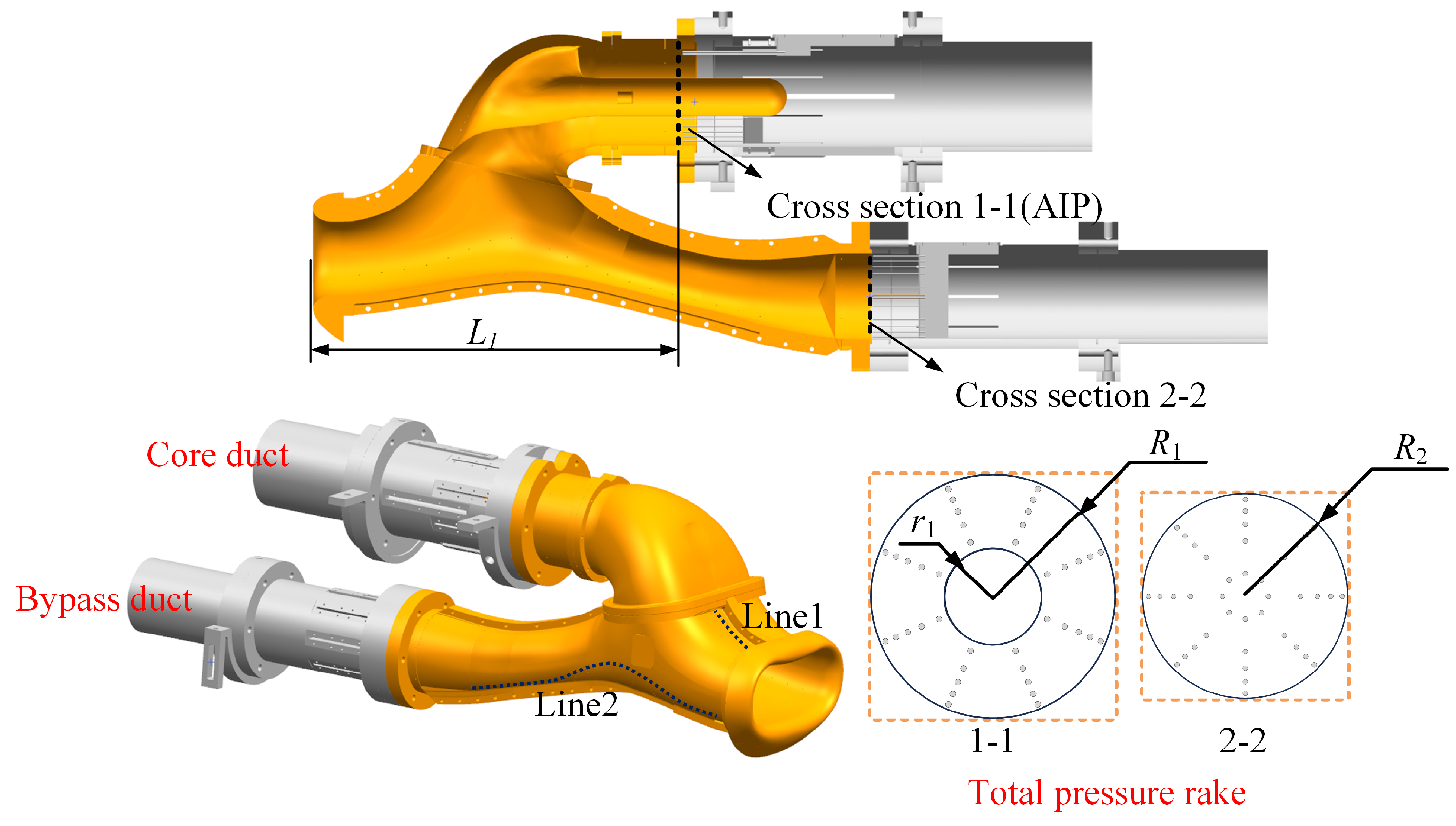
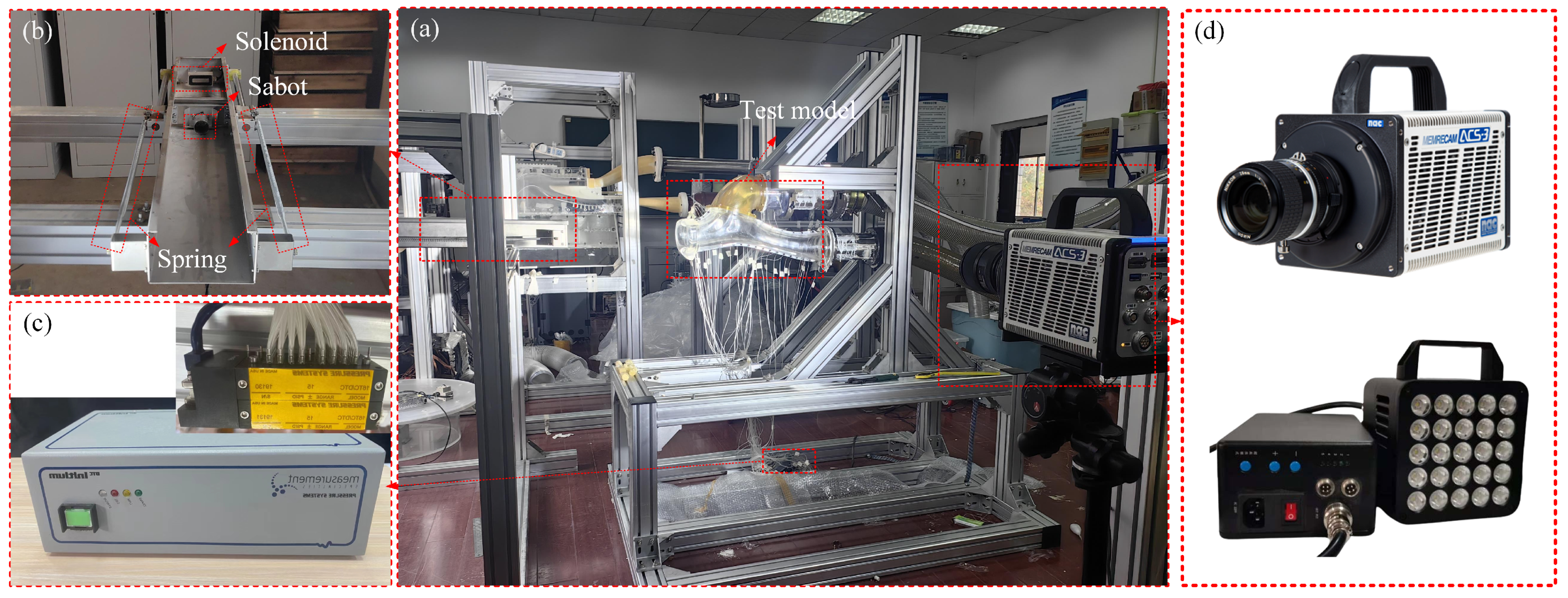

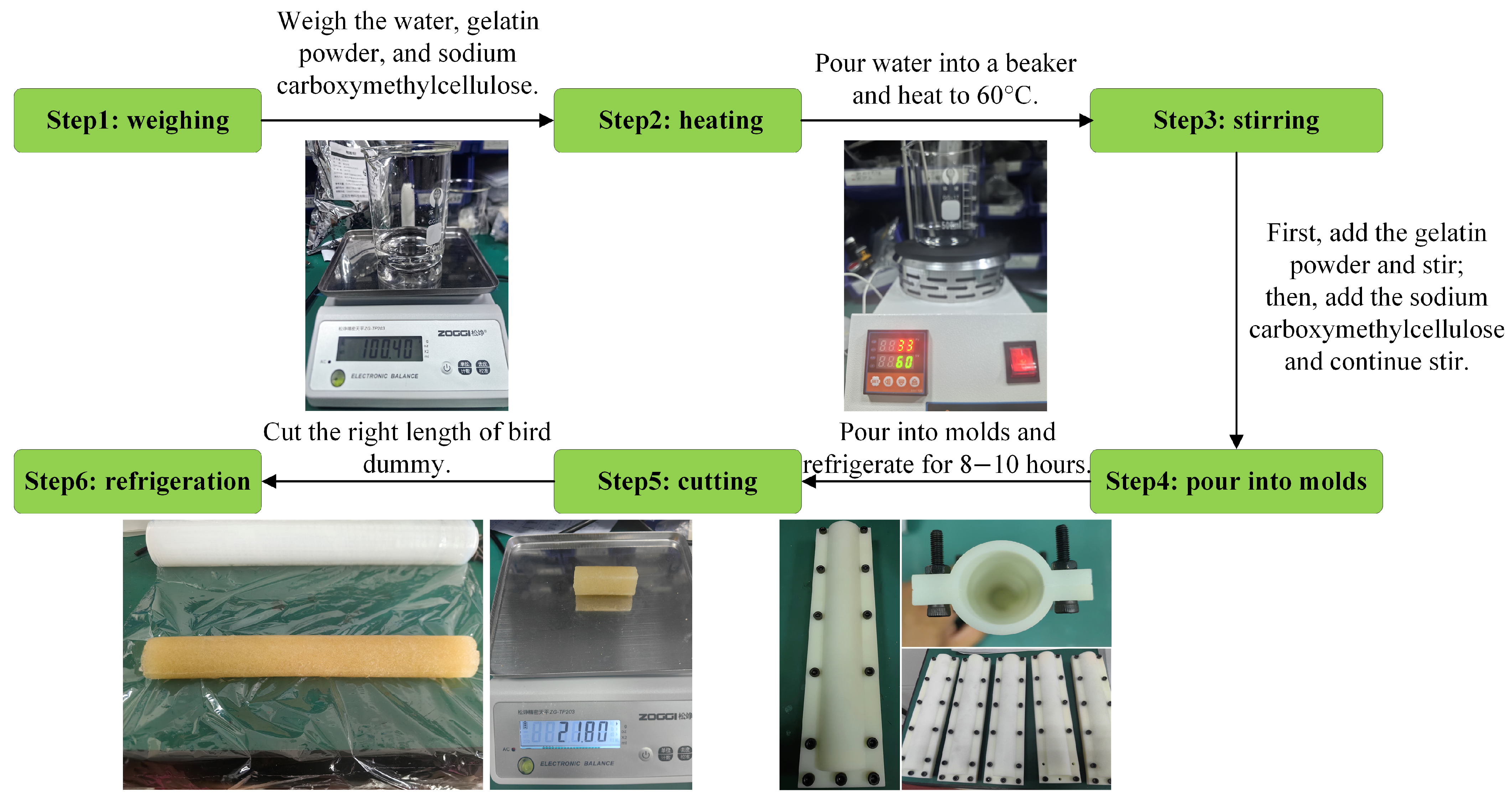
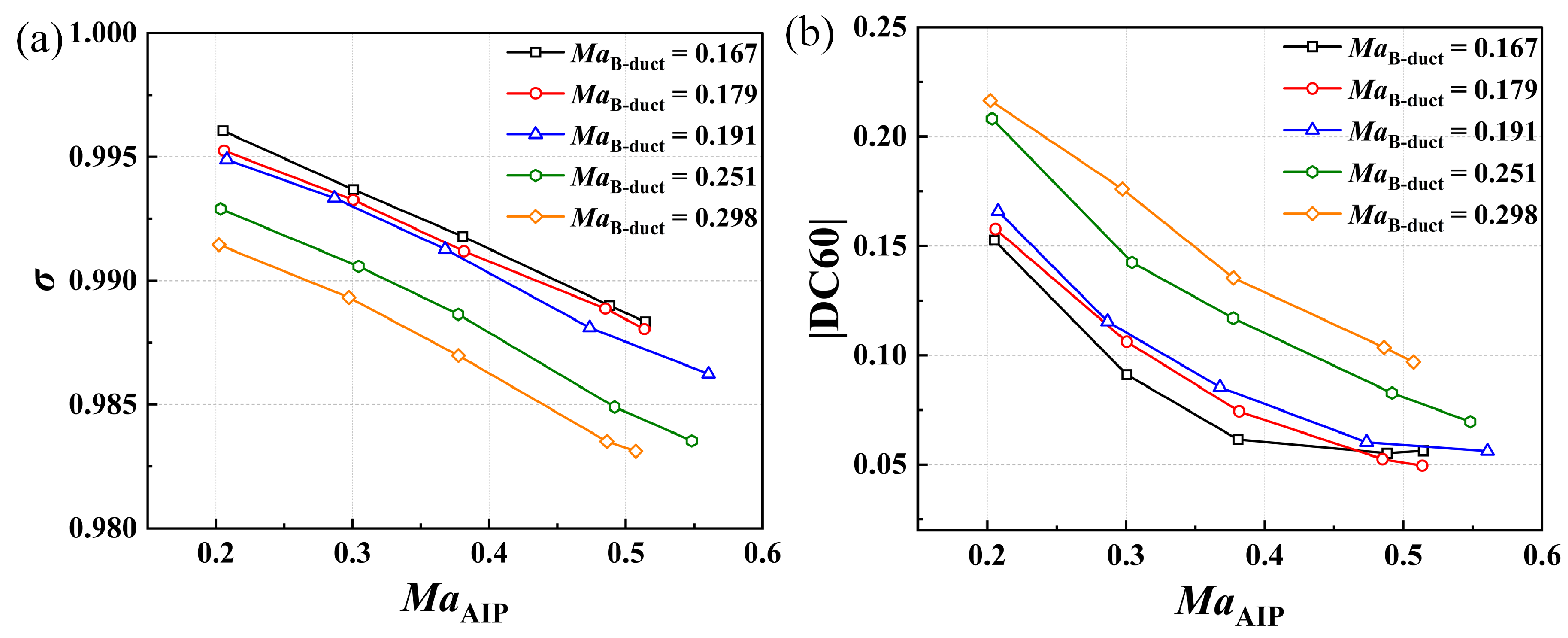
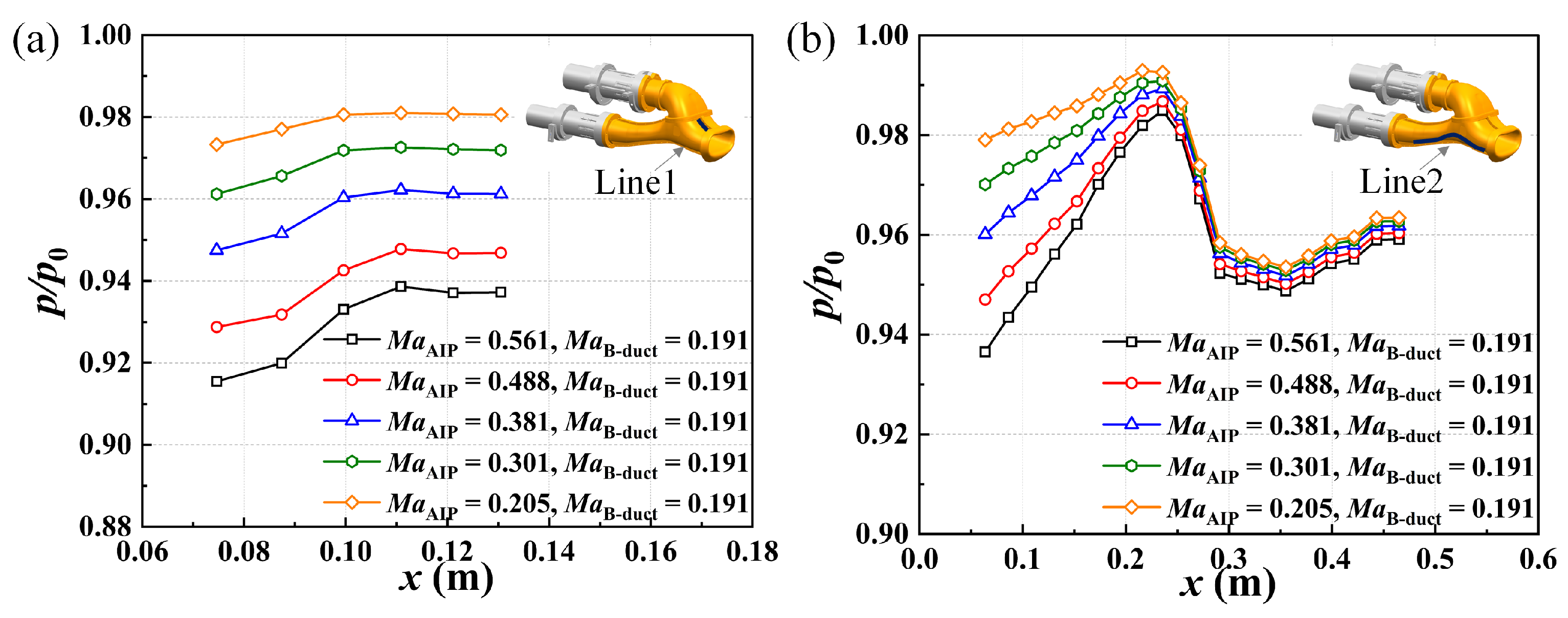
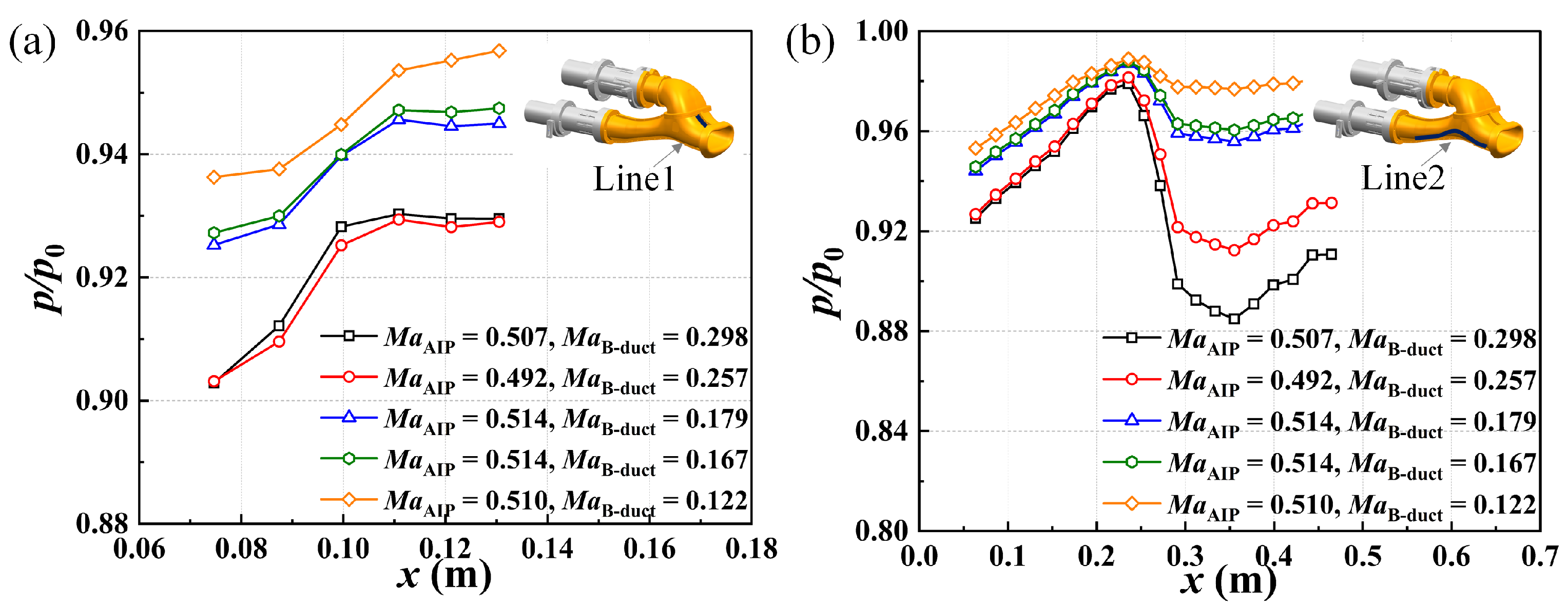

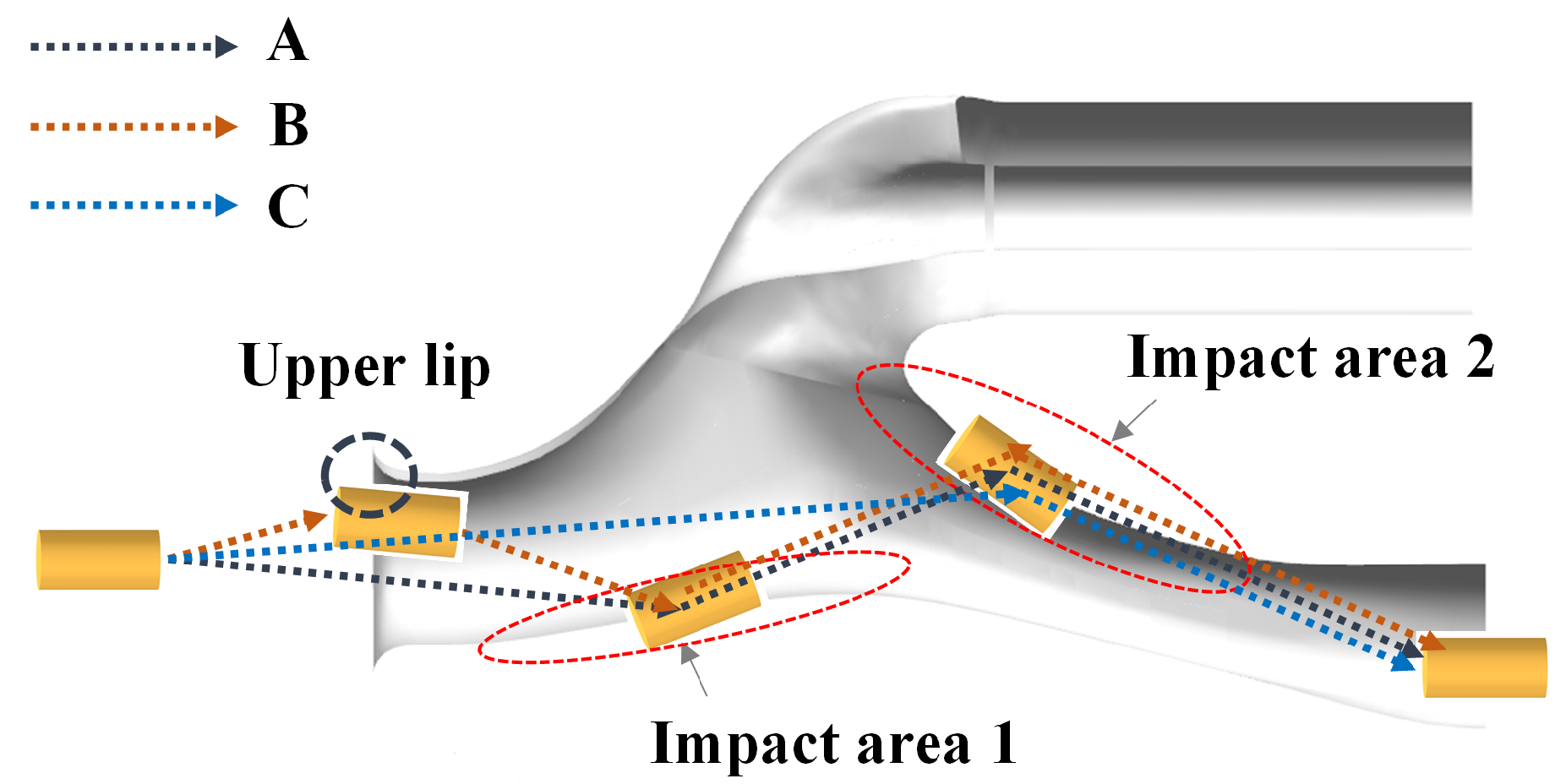


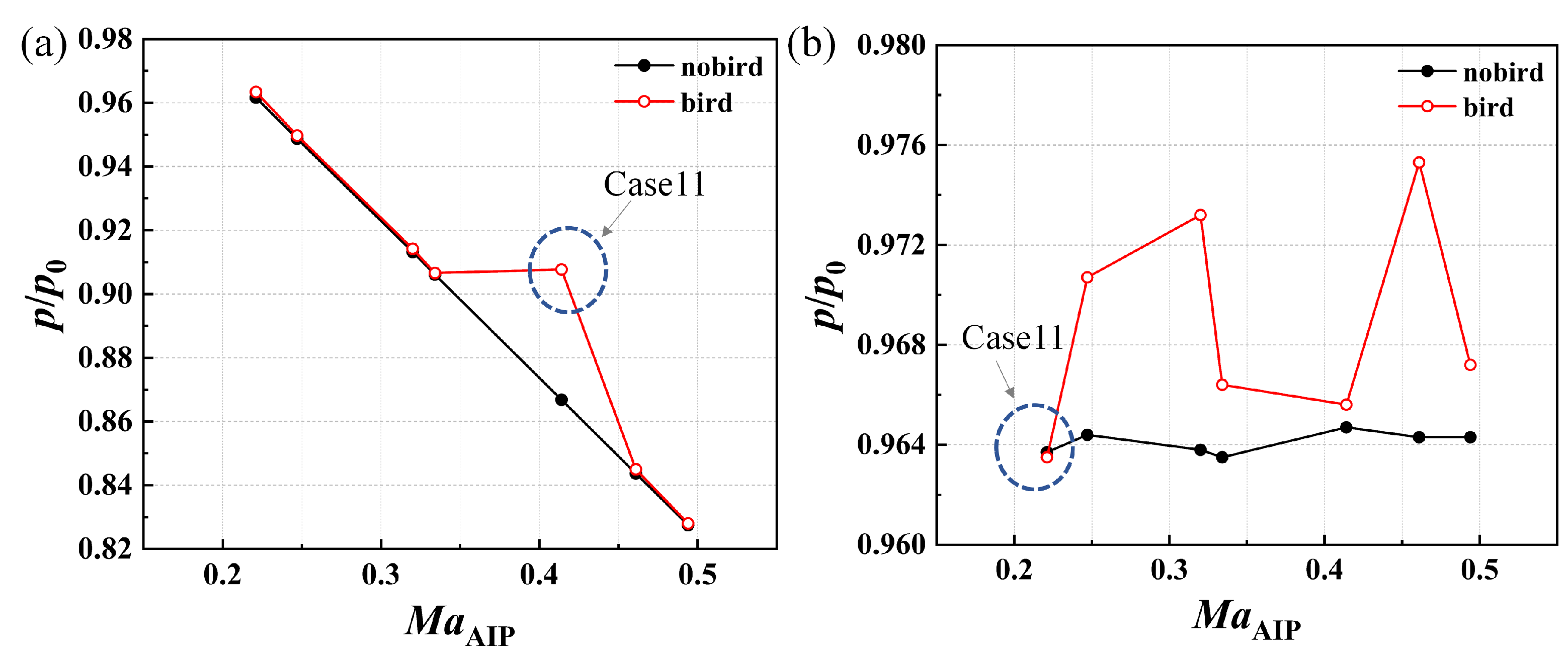

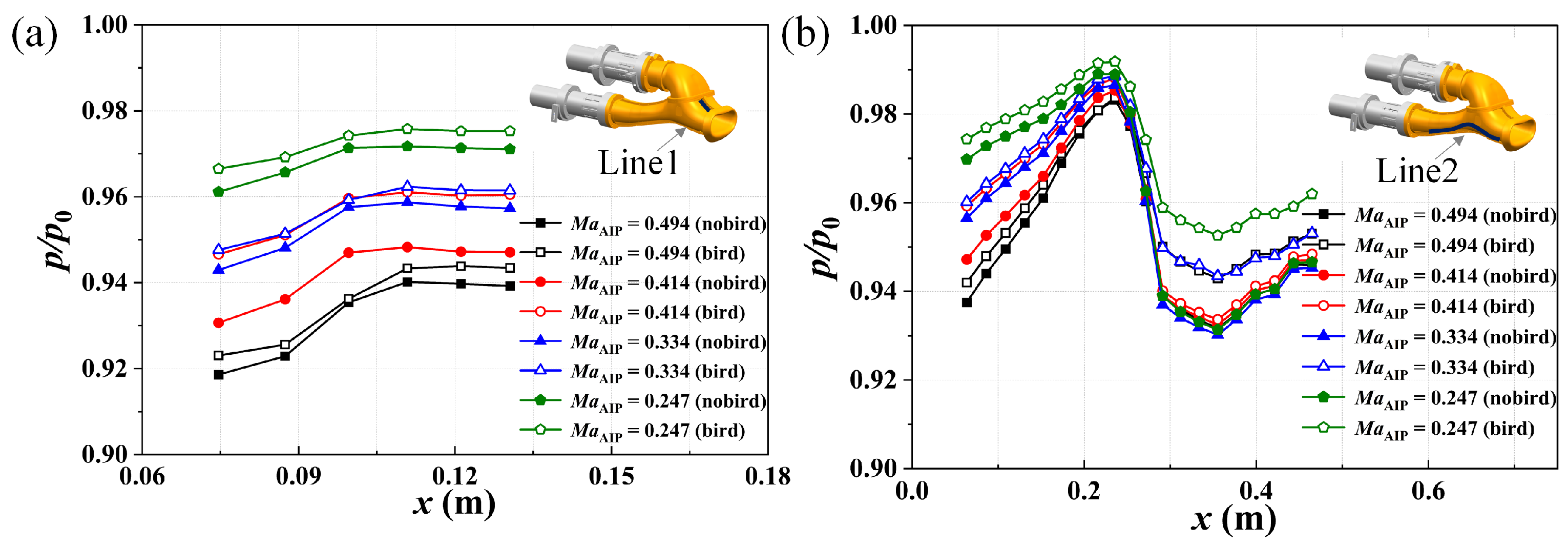

| Parameter | Units | Value |
|---|---|---|
| Core duct outside radius, | mm | 48.3 |
| Core duct inside radius, | mm | 19 |
| Bypass duct radius, | mm | 43 |
| Distance of entrance from AIP, | mm | 352.8 |
| Inlet throat area, | mm2 | 13,000 |
| Core duct exit area, | mm2 | 6195 |
| Bypass duct exit area, | mm2 | 5809 |
| Parameter | Units | Value |
|---|---|---|
| Bird dummy length, | m | 0.048 |
| Bird dummy weight, | kg | 0.021 |
| Run | |DC60| | |||
|---|---|---|---|---|
| 1 | 0.514 | 0.167 | 0.9883 | 0.0563 |
| 2 | 0.488 | 0.167 | 0.9890 | 0.0551 |
| 3 | 0.381 | 0.167 | 0.9918 | 0.0615 |
| 4 | 0.301 | 0.167 | 0.9937 | 0.0911 |
| 5 | 0.205 | 0.167 | 0.9960 | 0.1526 |
| 6 | 0.514 | 0.179 | 0.9880 | 0.0496 |
| 7 | 0.485 | 0.179 | 0.9889 | 0.0524 |
| 8 | 0.382 | 0.179 | 0.9912 | 0.0744 |
| 9 | 0.300 | 0.179 | 0.9933 | 0.1062 |
| 10 | 0.206 | 0.179 | 0.9952 | 0.1577 |
| 11 | 0.561 | 0.191 | 0.9862 | 0.0561 |
| 12 | 0.474 | 0.191 | 0.9881 | 0.0602 |
| 13 | 0.368 | 0.191 | 0.9913 | 0.0854 |
| 14 | 0.287 | 0.191 | 0.9933 | 0.1154 |
| 15 | 0.208 | 0.191 | 0.9949 | 0.1658 |
| 16 | 0.548 | 0.257 | 0.9835 | 0.0696 |
| 17 | 0.492 | 0.257 | 0.9849 | 0.0827 |
| 18 | 0.377 | 0.257 | 0.9886 | 0.1170 |
| 19 | 0.304 | 0.257 | 0.9906 | 0.1425 |
| 20 | 0.203 | 0.257 | 0.9929 | 0.2081 |
| 21 | 0.507 | 0.298 | 0.9831 | 0.0969 |
| 22 | 0.486 | 0.298 | 0.9835 | 0.1036 |
| 23 | 0.377 | 0.298 | 0.9870 | 0.1354 |
| 24 | 0.297 | 0.298 | 0.9893 | 0.1761 |
| 25 | 0.202 | 0.298 | 0.9914 | 0.2165 |
| 26 | 0.441 | 0.331 | 0.9832 | 0.1316 |
| 27 | 0.381 | 0.331 | 0.9853 | 0.1498 |
| 28 | 0.285 | 0.331 | 0.9886 | 0.1939 |
| 29 | 0.510 | 0.122 | 0.9897 | 0.0659 |
| 30 | 0.533 | 0.182 | 0.9871 | 0.0559 |
| Case | (m/s) | Outcome | Excluded? | |||
|---|---|---|---|---|---|---|
| 1 | 3.81 | −9.87° | 0.494 | 0.208 | A | Yes |
| 2 | 6.54 | −1.43° | 0.461 | 0.209 | B | Yes |
| 3 | 5.27 | 1.26° | 0.414 | 0.208 | D | No |
| 4 | 3.82 | −3.28° | 0.355 | 0.215 | A | Yes |
| 5 | 8.48 | −2.95° | 0.334 | 0.211 | A | Yes |
| 6 | 5.34 | −1.17° | 0.333 | 0.200 | C | Yes |
| 7 | 4.74 | 0° | 0.320 | 0.210 | A | Yes |
| 8 | 6.37 | −3.83° | 0.283 | 0.205 | A | Yes |
| 9 | 6.73 | −3.01° | 0.247 | 0.208 | A | Yes |
| 10 | 1.67 | 0° | 0.221 | 0.202 | C | Yes |
| 11 | 4.77 | −13.83° | 0.221 | 0.210 | D | No |
| 12 | 5.77 | −1.08° | 0.352 | 0.173 | A | Yes |
| 13 | 5.44 | −9.94° | 0.353 | 0.263 | A | Yes |
| 14 | 4.32 | −16.84° | 0.450 | 0.176 | D | No |
| 15 | 3.81 | −10.01° | 0.462 | 0.235 | A | Yes |
| 16 | 3.76 | −2.49° | 0.452 | 0.259 | A | Yes |
| Case | Is There a Bird? | ||||
|---|---|---|---|---|---|
| 1 | 0.494 | 0.208 | 0.8275 | 0.9643 | No |
| 0.8280 | 0.9672 | Yes | |||
| 2 | 0.461 | 0.209 | 0.8437 | 0.9643 | No |
| 0.8450 | 0.9753 | Yes | |||
| 3 | 0.414 | 0.208 | 0.8668 | 0.9647 | No |
| 0.9077 | 0.9656 | Yes | |||
| 4 | 0.355 | 0.215 | 0.8959 | 0.9622 | No |
| 0.8961 | 0.9644 | Yes | |||
| 5 | 0.334 | 0.211 | 0.9061 | 0.9635 | No |
| 0.9066 | 0.9664 | Yes | |||
| 6 | 0.333 | 0.200 | 0.9068 | 0.9673 | No |
| 0.9067 | 0.9746 | Yes | |||
| 7 | 0.320 | 0.210 | 0.9132 | 0.9638 | No |
| 0.9142 | 0.9732 | Yes | |||
| 8 | 0.283 | 0.205 | 0.9311 | 0.9654 | No |
| 0.9318 | 0.9718 | Yes | |||
| 9 | 0.247 | 0.208 | 0.9487 | 0.9644 | No |
| 0.9497 | 0.9707 | Yes | |||
| 10 | 0.221 | 0.202 | 0.9619 | 0.9665 | No |
| 0.9629 | 0.9770 | Yes | |||
| 11 | 0.221 | 0.210 | 0.9616 | 0.9637 | No |
| 0.9634 | 0.9635 | Yes | |||
| 12 | 0.352 | 0.173 | 0.8976 | 0.9758 | No |
| 0.8986 | 0.9804 | Yes | |||
| 13 | 0.353 | 0.263 | 0.8968 | 0.9465 | No |
| 0.8997 | 0.9742 | Yes | |||
| 14 | 0.450 | 0.176 | 0.8493 | 0.9750 | No |
| 0.9028 | 0.9753 | Yes | |||
| 15 | 0.462 | 0.235 | 0.8432 | 0.9555 | No |
| 0.8451 | 0.9692 | Yes | |||
| 16 | 0.452 | 0.259 | 0.8483 | 0.9477 | No |
| 0.8519 | 0.9718 | Yes |
Disclaimer/Publisher’s Note: The statements, opinions and data contained in all publications are solely those of the individual author(s) and contributor(s) and not of MDPI and/or the editor(s). MDPI and/or the editor(s) disclaim responsibility for any injury to people or property resulting from any ideas, methods, instructions or products referred to in the content. |
© 2025 by the authors. Licensee MDPI, Basel, Switzerland. This article is an open access article distributed under the terms and conditions of the Creative Commons Attribution (CC BY) license (https://creativecommons.org/licenses/by/4.0/).
Share and Cite
Zhou, G.; Wu, Z.; Tan, H. Experimental Study of Aerodynamic and Bird Exclusion Characteristics of a Branched Turboprop Inlet Under Ground Suction Conditions. Aerospace 2025, 12, 640. https://doi.org/10.3390/aerospace12070640
Zhou G, Wu Z, Tan H. Experimental Study of Aerodynamic and Bird Exclusion Characteristics of a Branched Turboprop Inlet Under Ground Suction Conditions. Aerospace. 2025; 12(7):640. https://doi.org/10.3390/aerospace12070640
Chicago/Turabian StyleZhou, Ge, Zhenlong Wu, and Huijun Tan. 2025. "Experimental Study of Aerodynamic and Bird Exclusion Characteristics of a Branched Turboprop Inlet Under Ground Suction Conditions" Aerospace 12, no. 7: 640. https://doi.org/10.3390/aerospace12070640
APA StyleZhou, G., Wu, Z., & Tan, H. (2025). Experimental Study of Aerodynamic and Bird Exclusion Characteristics of a Branched Turboprop Inlet Under Ground Suction Conditions. Aerospace, 12(7), 640. https://doi.org/10.3390/aerospace12070640








